Influence of Tropical Cyclones on Outdoor Wind Environment in High-Rise Residential Areas in Zhejiang Province, China
Abstract
:1. Introduction
2. Investigation on High-Rise Residential Areas in Zhejiang Provinces, China
3. Methods of Numerical Simulation of Wind Environment
3.1. Verification of Numerical Simulation Method
3.2. Analysis of Wind Speed Affected by Tropical Cyclones
3.3. Numerical Simulation of High-Rise Residential Buildings
3.3.1. Simplifying the Model
3.3.2. Setting the Computational Domain
3.3.3. Mesh Generation
3.3.4. The Physical Model
3.3.5. Setting of Boundary Conditions
3.4. Mesh Sensitivity Analysis
4. Results
4.1. Results of Numerical Simulation of Wind Environment in Coastal Cities
4.1.1. High-Rise Residential Areas with a Rows-Style Layout
4.1.2. High-Rise Residential Buildings with a Free-Style Layout
4.1.3. High-Rise Residential Buildings with a Courtyard-Style Layout
4.2. Results of Numerical Simulation of Wind Environment in Inland Cities of Coastal Provinces
4.2.1. High-Rise Residential Areas with a Rows-Style Layout
4.2.2. High-Rise Residential Buildings with a Free-Style Layout
4.2.3. High-Rise Residential Buildings with a Courtyard-Style Layout
5. Discussion
6. Conclusions
Supplementary Materials
Author Contributions
Funding
Institutional Review Board Statement
Informed Consent Statement
Data Availability Statement
Acknowledgments
Conflicts of Interest
References
- Yin, Y.; Gemmer, M.; Luo, Y.; Wang, Y. Tropical cyclones and heavy rainfall in Fujian Province, China. Quat. Int. 2010, 226, 122–128. [Google Scholar] [CrossRef]
- Liu, K.; Shen, C.; Louie, K. A 1,000-Year History of Typhoon Landfalls in Guangdong, Southern China, Reconstructed from Chinese Historical Documentary Records. Ann. Assoc. Am. Geogr. 2001, 91, 453–464. [Google Scholar] [CrossRef]
- Fengjin, X.; Ziniu, X. Characteristics of tropical cyclones in China and their impacts analysis. Nat. Hazards 2010, 54, 827–837. [Google Scholar] [CrossRef]
- Vivek, G.; Srinivasa Kumar, T. Impact Assessment of Tropical Cyclone Hud Hud on Coastal Region of Visakhapatnam, Andhra Pradesh, India. ISPRS Ann. Photogramm. Remote Sens. Spat. Inf. Sci. 2015, 2, 123–130. [Google Scholar] [CrossRef] [Green Version]
- Xu, S.; Zhu, X.; Helmer, E.H.; Tan, X.; Tian, J.; Chen, X. The damage of urban vegetation from super typhoon is associated with landscape factors: Evidence from Sentinel-2 imagery. Int. J. Appl. Earth Obs. Geoinf. 2021, 104, 102536. [Google Scholar] [CrossRef]
- Yang, Q.; Gao, R.; Bai, F.; Li, T.; Tamura, Y. Damage to buildings and structures due to recent devastating wind hazards in East Asia. Nat. Hazards 2018, 92, 1321–1353. [Google Scholar] [CrossRef]
- Choi, E. Air ventilation in cities with dense high-rise developments. Proc. Inst. Civ. Eng. 2010, 163, 12–19. [Google Scholar] [CrossRef]
- Kuznetsov, S.; Butova, A.; Pospíšil, S. Influence of placement and height of high-rise buildings on wind pressure distribution and natural ventilation of low- and medium-rise buildings. Int. J. Vent. 2016, 15, 253–266. [Google Scholar] [CrossRef]
- Zhang, X.; Weerasuriya, A.U.; Zhang, X.; Tse, K.T.; Lu, B.; Li, C.Y.; Liu, C.H. Pedestrian wind comfort near a super-tall building with various configurations in an urban-like setting. Build. Simul. 2020, 13, 1385–1408. [Google Scholar] [CrossRef]
- Li, Q.; Li, X.; He, Y. Monitoring Wind Characteristics and Structural Performance of a Supertall Building during a Landfall Typhoon. J. Struct. Eng. 2016, 142, 04016097. [Google Scholar] [CrossRef]
- Wang, C.; Li, Z.; Hu, L.; Zhao, Z.; Luo, Q.; Hu, J.; Zhang, X. Field Research on the Wind-Induced Response of a Super High-Rise Building under Typhoon. Appl. Sci. 2019, 9, 2180. [Google Scholar] [CrossRef] [Green Version]
- Wang, C.; Li, Z.; Luo, Q.; Hu, L.; Zhao, Z.; Hu, J.; Zhang, X. Wind Characteristics Investigation on The Roofs of Three Adjacent High-Rise Buildings in a Coastal Area during Typhoon Meranti. Appl. Sci. 2019, 9, 367. [Google Scholar] [CrossRef] [Green Version]
- Li, X.; Li, Q.S. Observations of typhoon effects on a high-rise building and verification of wind tunnel predictions. J. Wind Eng. Ind. Aerodyn. 2019, 184, 174–184. [Google Scholar] [CrossRef]
- Yang, Z.; Sarkar, P.; Hu, H. An experimental study of a high-rise building model in tornado-like winds. J. Fluids Struct. 2011, 27, 471–486. [Google Scholar] [CrossRef]
- Zhang, L.; Hu, X.; Xie, Z.; Shi, B.; Zhang, L.; Wang, R. Field measurement study on time-varying characteristics of modal parameters of super high-rise buildings during super typhoon. J. Wind Eng. Ind. Aerodyn. 2020, 200, 104139. [Google Scholar] [CrossRef]
- Amini, M.; Memari, A.M. Performance of Residential Buildings in Hurricane Prone Coastal Regions and Lessons Learned for Damage Mitigation. In Proceedings of the 5th Residential Building Design & Construction Conference, Conference Center Hotel in State College, State College, PA, USA, 4–6 March 2020. [Google Scholar]
- Ma, T.; Chen, T. Classification and pedestrian-level wind environment assessment among Tianjin’s residential area based on numerical simulation. Urban Clim. 2020, 34, 100702. [Google Scholar] [CrossRef]
- Nonomura, Y.; Kobayashi, N.; Tominaga, Y.; Mochida, A. The cross comparison of CFD results for flow field around building models (Part 3)—Wind tunnel test for the verification of models for the flow field around building blocks. Summ. Tech. Pap. Annu. Meet. Jpn. Assoc. Wind. Eng. 2003, 95, 83–84. [Google Scholar]
- Mochida, A.; Tominaga, Y.; Ishida, Y.; Ishihara, T.; Uehara, K.; Kataoka, H.; Kurabuchi, T.; Kobayashi, N.; Ooka, R.; Shirasawa, T.; et al. AIJ Benchmarks for Validation of CFD Simulations Applied to Pedestrian Wind Environment around Buildings; Architectural Institute of Japan: Tokyo, Japan, 2016. [Google Scholar]
- Zhang, C. Experimental Research on Wind Field and Wind Effect of High-Rise Buildings under Typhoon. Doctoral Thesis, Hunan University, Changsha, China, 2018. [Google Scholar]
- Li, L.; Cui, X.; Wang, C.; Bai, L. Characteristic Distribution of Surface Winds Associated with Landfalling Tropical Cyclones in Mainland China. Chin. J. Atmos. Sci. 2018, 42, 96–108. [Google Scholar]
- Tominaga, Y.; Mochida, A.; Yoshie, R.; Kataoka, H.; Nozu, T.; Yoshikawa, M.; Shirasawa, T. AIJ guidelines for practical applications of CFD to pedestrian wind environment around buildings. J. Wind Eng. Ind. Aerodyn. 2008, 96, 1749–1761. [Google Scholar] [CrossRef]
- Blocken, B. Computational Fluid Dynamics for urban physics: Importance, scales, possibilities, limitations and ten tips and tricks towards accurate and reliable simulations. Build. Environ. 2015, 91, 219–245. [Google Scholar] [CrossRef] [Green Version]
- Sosnowski, M.; Gnatowska, R.; Grabowska, K.; Krzywanski, J.; Jamrozik, A. Numerical Analysis of Flow in Building Arrangement: Computational Domain Discretization. Appl. Sci. 2019, 9, 941. [Google Scholar] [CrossRef] [Green Version]
- Hunt, J.C.R.; Poulton, E.C.; Mumford, J.C. The effects of wind on people; New criteria based on wind tunnel experiments. Build. Environ. 1976, 11, 15–28. [Google Scholar] [CrossRef]
- Melbourne, W.H. Criteria for environmental wind conditions. J. Wind Eng. Ind. Aerodyn. 1978, 3, 241–249. [Google Scholar] [CrossRef]
- Murakami, S.; Iwasa, Y.; Morikawa, Y. Study on acceptable criteria for assessing wind environment at ground level based on residents’ diaries. J. Wind Eng. Ind. Aerodyn. 1986, 24, 1–18. [Google Scholar] [CrossRef]
- Soligo, M.J.; Irwin, P.A.; Williams, C.J.; Schuyler, G.D. A comprehensive assessment of pedestrian comfort including thermal effects. J. Wind Eng. Ind. Aerodyn. 1998, 77–78, 753–766. [Google Scholar] [CrossRef]
- Hong, B.; Lin, B. Numerical studies of the outdoor wind environment and thermal comfort at pedestrian level in housing blocks with different building layout patterns and trees arrangement. Renew. Energy 2015, 73, 18–27. [Google Scholar] [CrossRef]
- Jin, H.; Liu, Z.; Jin, Y.; Kang, J.; Liu, J. The Effects of Residential Area Building Layout on Outdoor Wind Environment at the Pedestrian Level in Severe Cold Regions of China. Sustainability 2017, 9, 2310. [Google Scholar] [CrossRef] [Green Version]

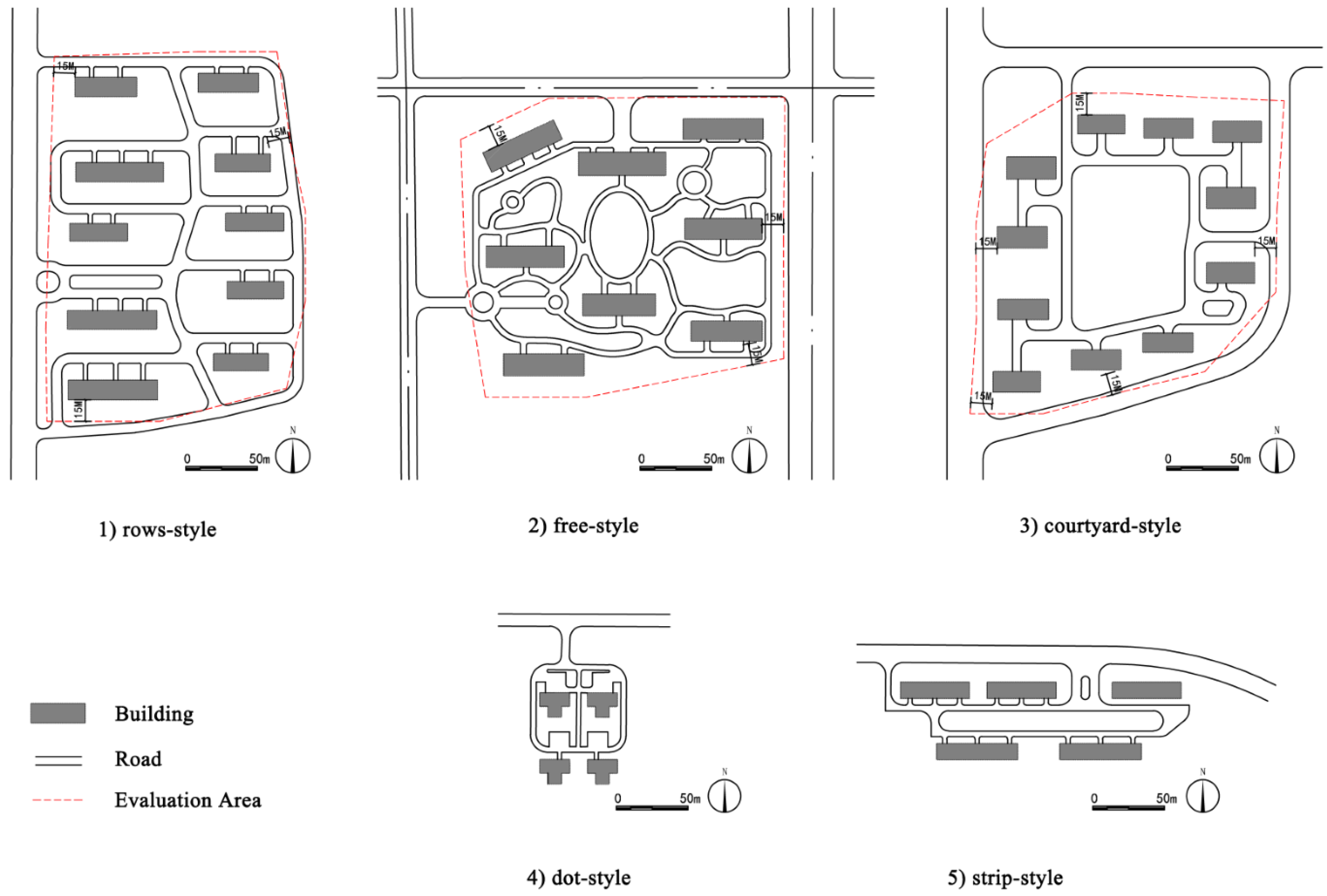
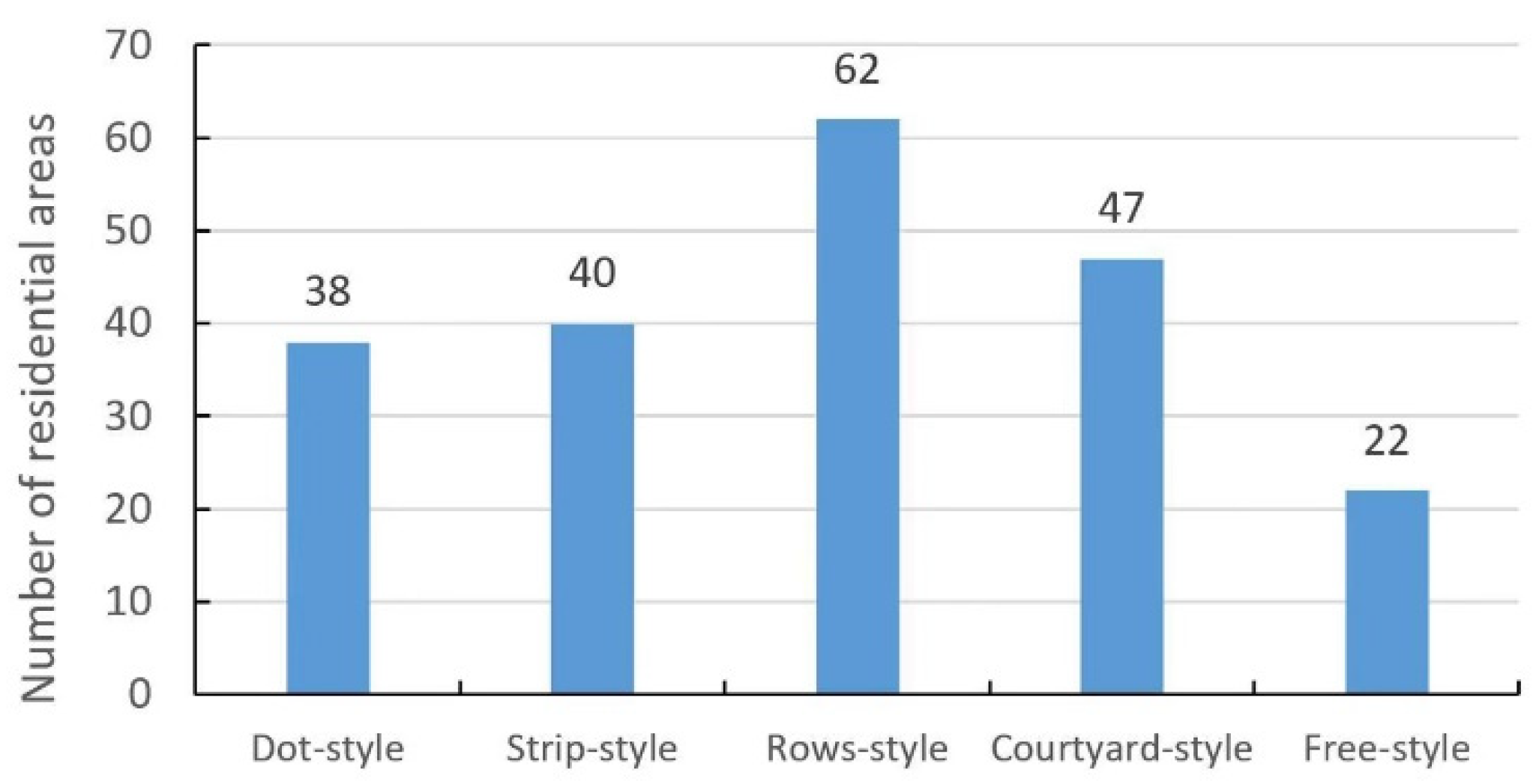
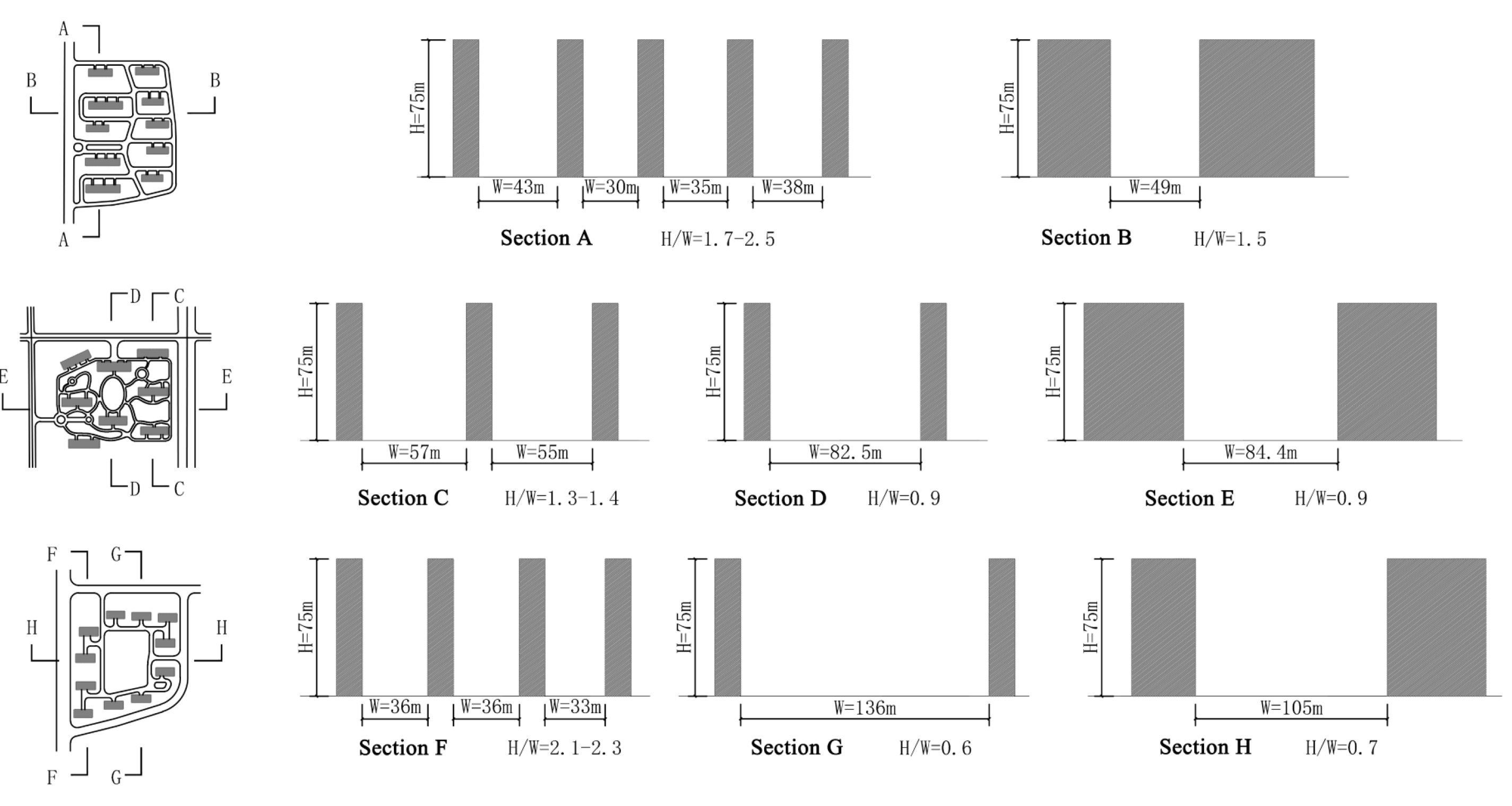

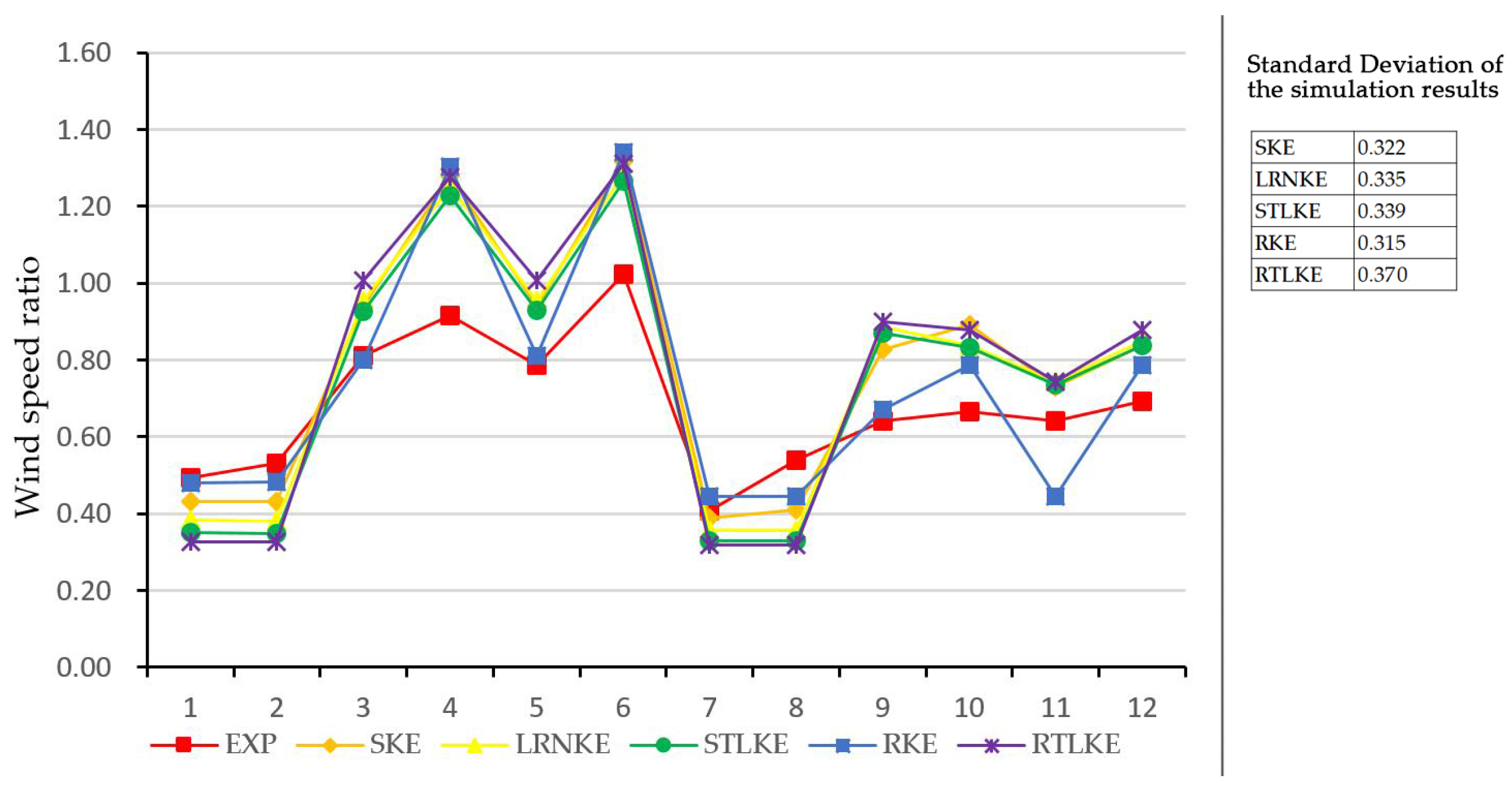
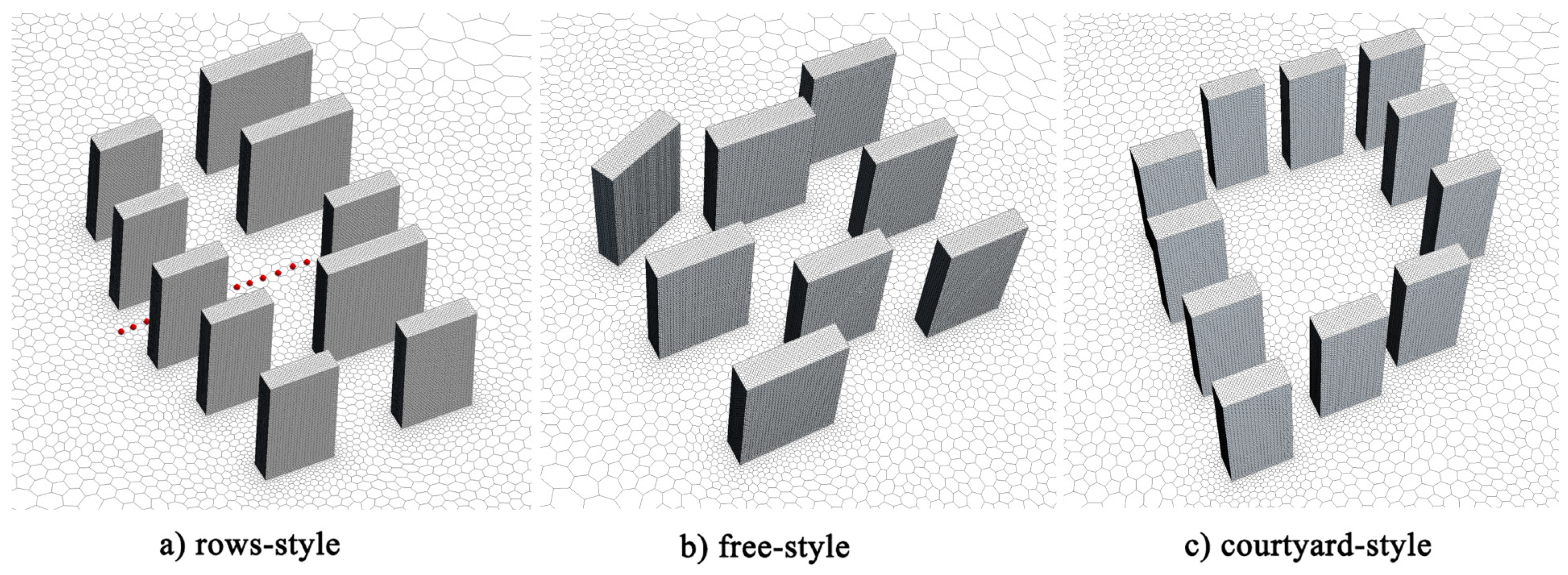

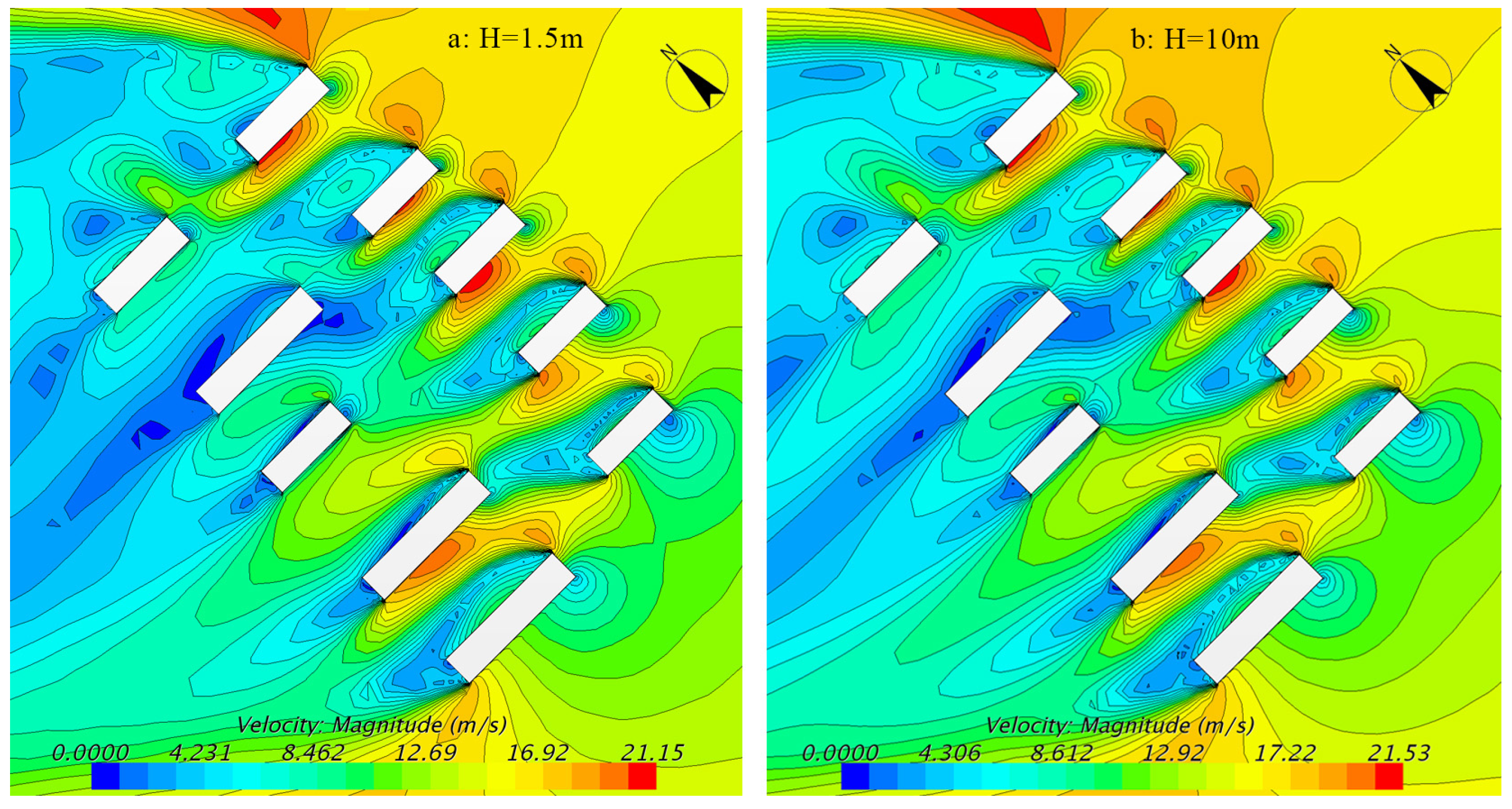


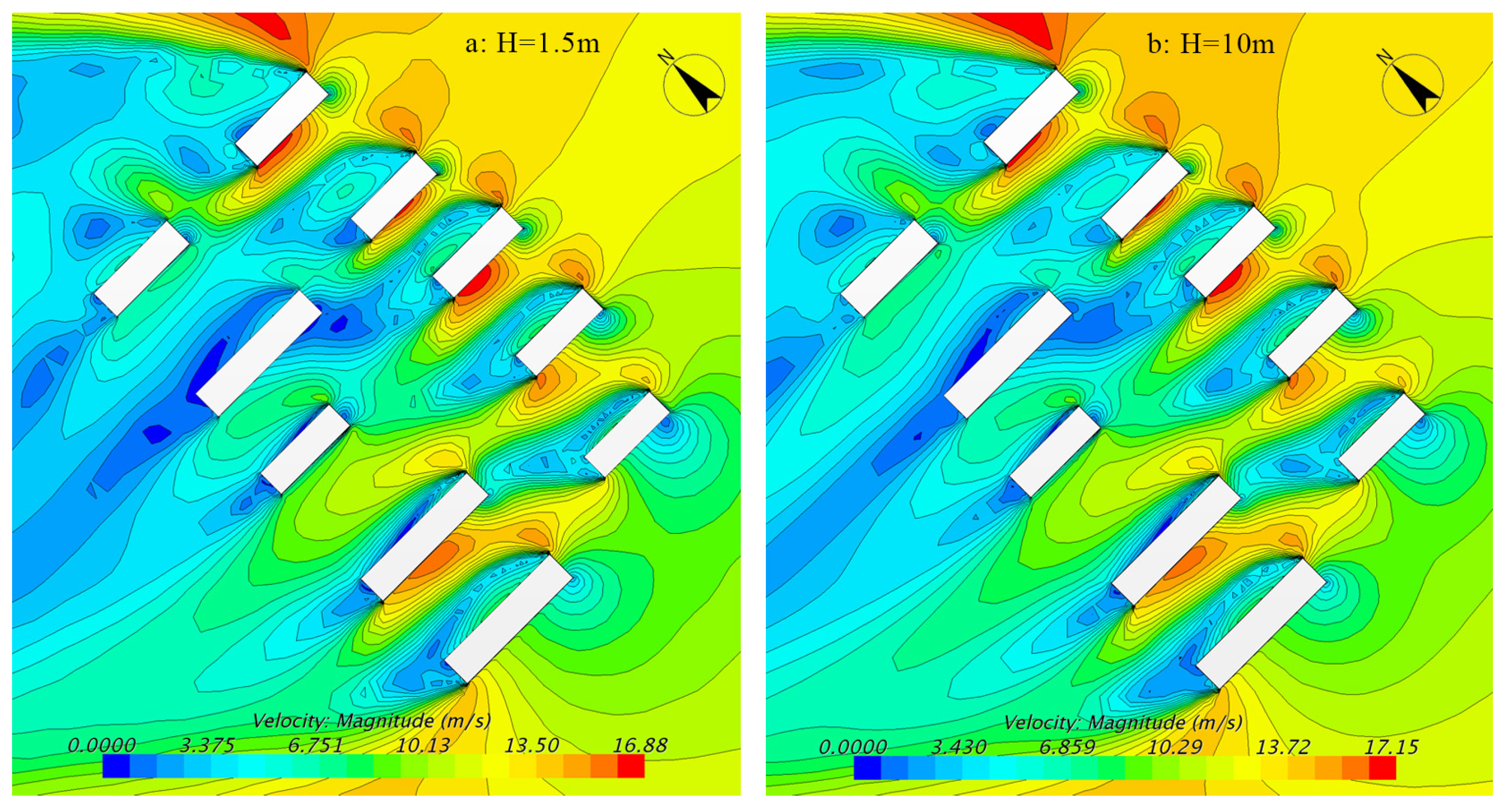
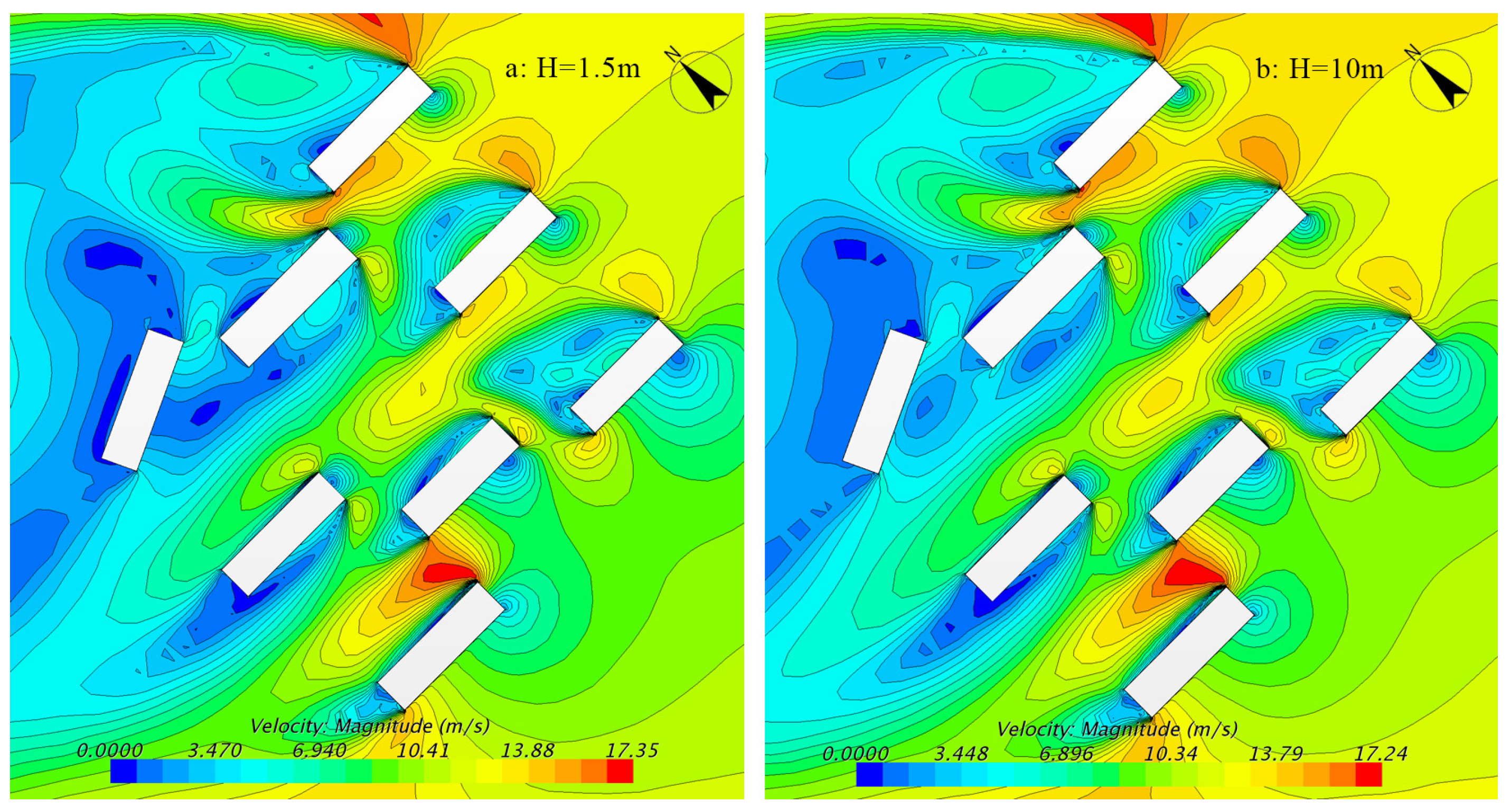
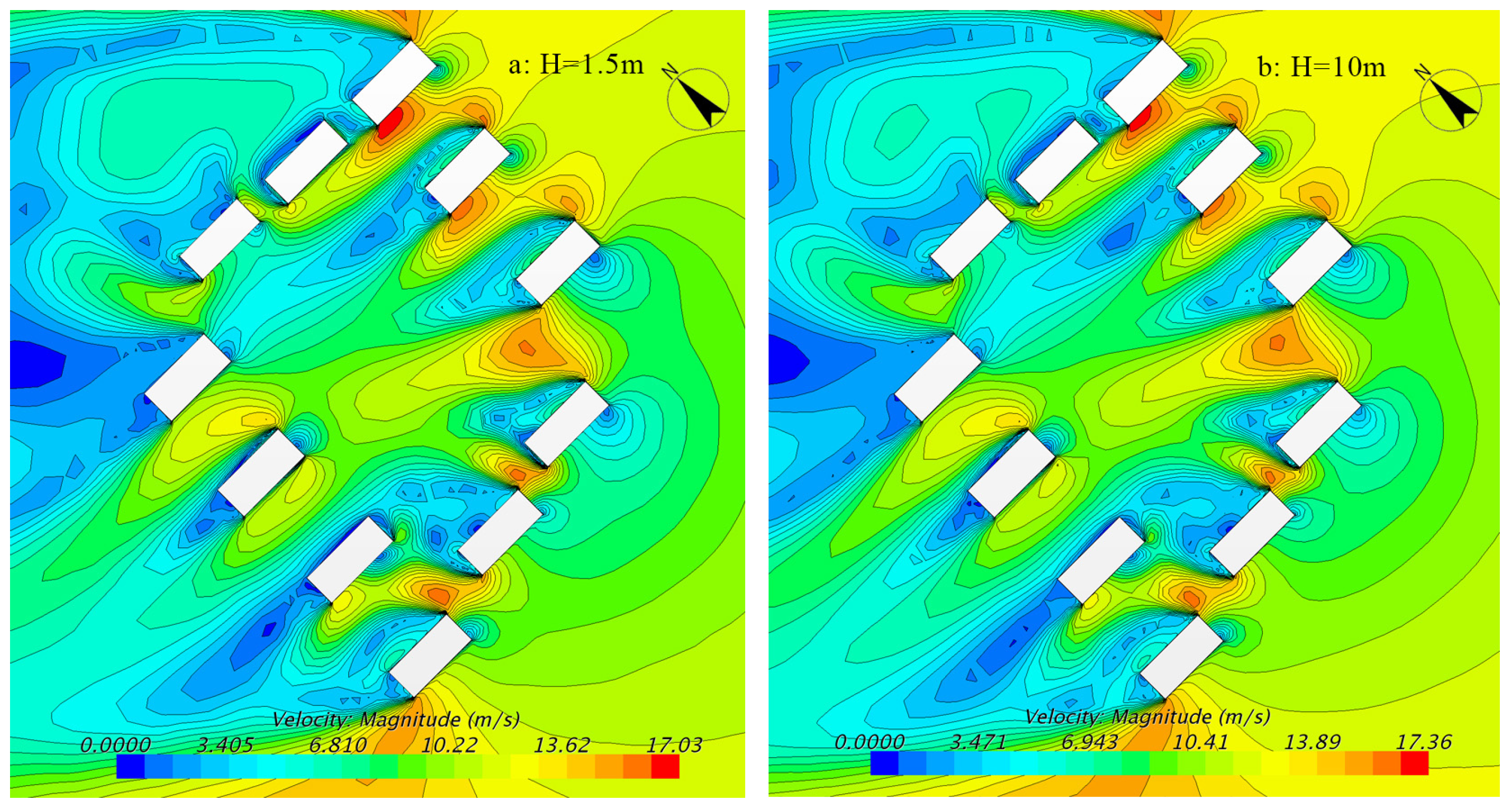
| Computational domain | 3.0 m× 2.0 m× 1.8 m. |
| Inflow boundary condition | Interpolated value of wind velocity (U) and turbulent kinetic energy (k) from the experimental approaching flow, ε was calculated by assuming that Pk = ε. |
| Outflow boundary condition | Zero-gradient condition. |
| Ground surface boundary | Logarithmic law with roughness length (z0 = 4.5 × 10−4 [m]). |
| Lateral and upper surfaces ofthe computational domain | Logarithmic law for a smooth surface wall. |
| Mesh discretization | Polyhedral meshes are used. Base mesh size was 0.12 m, the relative mesh size of the building was 10% of the base mesh size, and the relative mesh size in the area near the buildings was 16% of the base mesh size. The generated mesh is shown in Figure 5. |
| Turbulence model | The SKE mode, LRKE model, STLKE model, RKE model, and RTLKE model were selected. |
| Layout Form | Maximum Wind Speed | Proportion of Areas with Wind Speed Higher than 14.4 m/s | Area with High Wind Speed |
|---|---|---|---|
| Rows-style | 21.15 m/s | 19.3% | 7152 m2 |
| Freestyle | 21.66 m/s | 20.0% | 7426 m2 |
| Courtyard-style | 21.26 m/s | 16.6% | 6146 m2 |
| Layout Form | Maximum Wind Speed | Proportion of Areas with Wind Speed Higher than 14.4 m/s | Area with High Wind Speed |
|---|---|---|---|
| Rows-style | 21.53 m/s | 21.5% | 7967 m2 |
| Freestyle | 21.55 m/s | 23.6% | 8766 m2 |
| Courtyard-style | 21.71 m/s | 19.2% | 7108 m2 |
| Layout Form | Maximum Wind Speed | Proportion of Areas with Wind Speed Higher than 14.4 m/s | Area with High Wind Speed |
|---|---|---|---|
| Rows-style | 16.88 m/s | 4.4% | 1618 m2 |
| Freestyle | 17.35 m/s | 3.5% | 1293 m2 |
| Courtyard-style | 17.03 m/s | 4.2% | 1557 m2 |
| Layout Form | Maximum Wind Speed | Proportion of Areas with Wind Speed Higher than 14.4 m/s | Area with High Wind Speed |
|---|---|---|---|
| Rows-style | 17.15 m/s | 5.4% | 2002 m2 |
| Freestyle | 17.24 m/s | 4.2% | 1566 m2 |
| Courtyard-style | 17.36 m/s | 4.9% | 1806 m2 |
Publisher’s Note: MDPI stays neutral with regard to jurisdictional claims in published maps and institutional affiliations. |
© 2022 by the authors. Licensee MDPI, Basel, Switzerland. This article is an open access article distributed under the terms and conditions of the Creative Commons Attribution (CC BY) license (https://creativecommons.org/licenses/by/4.0/).
Share and Cite
Zhang, H.; Xiong, M.; Chen, B.; Wang, Y. Influence of Tropical Cyclones on Outdoor Wind Environment in High-Rise Residential Areas in Zhejiang Province, China. Sustainability 2022, 14, 3932. https://doi.org/10.3390/su14073932
Zhang H, Xiong M, Chen B, Wang Y. Influence of Tropical Cyclones on Outdoor Wind Environment in High-Rise Residential Areas in Zhejiang Province, China. Sustainability. 2022; 14(7):3932. https://doi.org/10.3390/su14073932
Chicago/Turabian StyleZhang, Hua, Minghui Xiong, Bing Chen, and Yanfeng Wang. 2022. "Influence of Tropical Cyclones on Outdoor Wind Environment in High-Rise Residential Areas in Zhejiang Province, China" Sustainability 14, no. 7: 3932. https://doi.org/10.3390/su14073932
APA StyleZhang, H., Xiong, M., Chen, B., & Wang, Y. (2022). Influence of Tropical Cyclones on Outdoor Wind Environment in High-Rise Residential Areas in Zhejiang Province, China. Sustainability, 14(7), 3932. https://doi.org/10.3390/su14073932







